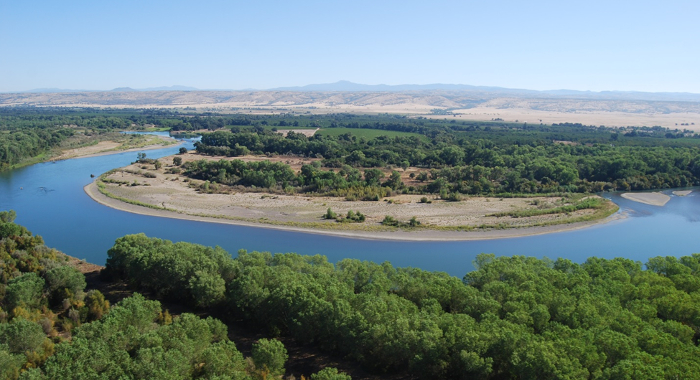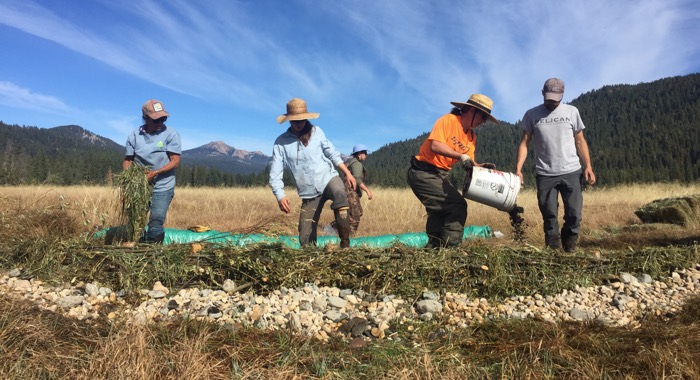Californians have fundamentally altered many of the state’s rivers and streams with dams, pipes, and diversions, and the State is home to some of the world’s most complex water delivery projects. As an unfortunate consequence, habitat for many freshwater species has been degraded or destroyed.
But, is it necessary to tradeoff the freshwater needs of birds, fish, and other species against the needs of farms and cities? Could freshwater flows be managed to better mimic the dynamics of their unimpaired past, dynamics to which native species have adapted and need to persist? And how should climate change considerations be incorporated into water management, to enhance the resilience of freshwater systems for both people and nature?
Our science is focused on tackling these questions.


Travis M. Hinkelman, Myfanwy Johnston, Joseph E. Merz, Julie Zimmerman
To restore degraded stream corridors and develop large-scale, sustainable watershed conservation strategies, it is essential for managers to consider—in order to ultimately…Brian Cohen, Shona Ganguly, Sophie Parker, John Randall, Jill Sourial, and Lara Weatherly of The Nature Conservancy, Land IQ, Natural History Museum Los Angeles County, WRC Consulting Services Inc., Travis Longcore, University of Southern California, Connective Issue, Inc.
As a basic principle of ecological systems, a watershed’s hydrology determines the flow characteristics of its river system. These flows define what the biological characteristics of that…Sophie S. Parker, Jim Moore, Leonard Warren
The 185 mile-long Amargosa River, one of only two rivers with perennial flow in the California portion of the Mojave Desert, is fed by an ancient groundwater aquifer. The river provides habitat for…Alexander C.A.D., F. Poulsen, D.C.E. Robinson, B.O. Ma , R.A. Luster
Management of the Sacramento River and Sacramento–San Joaquin Delta is one of California’s greatest challenges, requiring trade-offs between valued components that serve a multiplicity of…Justine E. Hausheer, Mark D. Reynolds, Greg Golet
Gregory H. Golet, Candace Low, Simon Avery, Katie Andrews, Christopher J. McColl, Rheyna Laney, Mark D. Reynolds
Migratory birds face great challenges due to the climate change, conversion of historical stopover sites, and other factors. To help address these challenges, the Conservancy launched a dynamic…Darren W. Mierau, William J. Trush, Gabriel J. Rossi, Jennifer K. Carah, Matthew O. Clifford, Jeanette K. Howard
The California water rights system often dis-incentivizes water management that benefits both nature and people by directing the timing of diversions to the summer when water is the most scarce. It…Julie K H Zimmerman, Daren M. Carlisle, Jason T. May, Kirk R. Klausmeyer, Theodore E. Grantham, Larry R. Brown, Jeanette K. Howard
The importance of the natural flow regime to stream and river health has received growing attention in recent years. Understanding natural flows and patterns of flow alteration is an important first…Kristen E. Dybala, Neil Clipperton, Thomas Gardali, Gregory H. Golet, Rodd Kelsey, Stefan Lorenzato, Ron Melcer, Jr., Nathaniel E. Seavy, Joseph G. Silveira
The Conservancy and partners are working to establish riparian ecosystems that provide sufficient habitat to support genetically robust, self-sustaining, and resilient bird populations in…Kristen Wilson, Erik Lowe, Stacey Wolny, Barry Nickel , Rodd Kelsey
This study demonstrates how science-based planning with stakeholder input can improve and direct conservation investments across existing state and jurisdictional boundaries. The authors set out to…Burns, C.E., A. Hoss, N. Smith, K. Klausmeyer, K. Fesenmeyer, A. Campbell, J. Carah, E. Forsburg, S. Heard, J.K. Howard, L. Hulette, S. Liu, P. Spraycar, B. Stranko, G. Werner, D. Wordham
This report identifies a set of strategies that will have the greatest impact on environmental flows, and to provide a resource for conservation organizations, resource agencies, and other…Debra Perrone, Melissa M. Rohde
Managed aquifer recharge (MAR) projects can play an important role in ensuring California manages its groundwater sustainably. This study, the first to investigate the benefits and economic costs…Christopher J. McColl, Katie Andrews, Mark Reynolds, Gregory H. Golet
In response to the decline of wetland habitats for migrating and wintering water birds in California, the Conservancy developed a program called BirdReturns that creates “pop-up”…The Nature Conservancy, RMC Consultants, Inc.
Groundwater is intimately connected to surface water, which has profound implications for sustainable water resource management. California has historically overlooked this important interaction and…